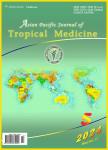Molecular detection of Leishmania species in human and animals from cutaneous leishmaniasis endemic areas of Waziristan, Khyber Pakhtunkhwa, Pakistan
Molecular detection of Leishmania species in human and animals from cutaneous leishmaniasis endemic areas of Waziristan, Khyber Pakhtunkhwa, Pakistan作者机构:Vector Borne Diseases Lab Department of Microbiology Kohat University of Science and Technology Kohat Faculty of Plant Protection Yunnan Agricultural University Institute of Biotechnology and Genetic Engineering The University of AgriculturePeshawar Pakistan Yunnan Provincial Key Laboratory of Animal Nutrition and Feed Yunnan Agricultural University College of Veterinary Medicine South China Agricultural University Department of Animal Breeding Genetics and Reproduction Yunnan Agricultural University Beijing Key Laboratory of Genetic Engineering Drug and Biotechnology Institute of Biochemistry and Biotechnology College of Life Sciences Beijing Normal University Vector Biology Research Lab US Naval Medical Research Unit 3
出 版 物:《Asian Pacific Journal of Tropical Medicine》 (亚太热带医药杂志(英文版))
年 卷 期:2018年第11卷第8期
页 面:495-500页
核心收录:
学科分类:1002[医学-临床医学] 100206[医学-皮肤病与性病学] 10[医学]
基 金:project entitled PCR and RFLP analysis of Leishmania species from suspected cutaneous leishmaniasis patients and animal reservoirs in Waziristan funded by Relief International Pakistan(DOSFY15)
主 题:Leishmania major Rodents Cutaneous leishmaniasis Domestic animals ITS 1 PCR Waziristan
摘 要:Objectives: To detect Leishmania species in human patients, animal reservoirs and Phlebotomus sandflies in Waziristan, Pakistan. Methods: Tissue smears and aspirates from 448 cutaneous leishmaniasis(CL) suspected patients were analyzed. To sort out role of the reservoir hosts, skin scrapings, spleen and liver samples from 104 rodents were collected. Furthermore, buffy coat samples were obtained from 60 domestic animals. Sandflies were also trapped. All human, animals and sandfly samples were tested by microscopy, kinetoplastic PCR and internal transcribed spacer 1(ITS1) PCR followed by restriction fragment length polymorphism for detection of Leishmania species. Results: An overall prevalence of 3.83% and 5.21% through microscopy and ITS1 PCR respectively was found. However, the statistically non-significant correlation was found between area, gender, and number of lesions. The presence of rodents, sandflies, domestic animals and internally displaced people increased the risk of CL. Using ITS1-PCR-RFLP, Leishmania tropica(L. tropica) was confirmed in 106 samples while 25 of the isolates were diagnosed as Leishmania major(L. major). Similarly, 3/104 rodents were positive for L. major and 14 pools of DNA samples containing Phlebotomus sergenti sandflies were positive for L. tropica. None of samples from domestic animals were positive for leishmaniasis. Conclusions: In the present study, L. tropica and L. major are found to be the main causative agents of CL in study area. Movement of internally displaced people from CL endemic areas presents a risk for nearby CL free areas. To the best of our knowledge, we report for the first time L. major infection in rodents(Rattus rattus) and L. tropica in Phlebotomus sergenti sandflies trapped in Waziristan, Pakistan.



